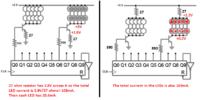Englewood
Full Member level 3

Awesome
What IC is that 4017?
- - - Updated - - -
Deacde Counter
Right i have some BC517 transistors
currents to 1.0A
Follow along with the video below to see how to install our site as a web app on your home screen.
Note: This feature may not be available in some browsers.









No. Since the output voltage from the Cmos digital IC goes almost as high as the positive supply then it makes no difference if the current-limiting resistor is at the load or at the emitter.Not only that, if you are using a NPN transistor the Emitter goes directly to ground. If there is a current limiting resistor it goes between the load and VCC rail, never between the emitter and GND.


Not only that, if you are using a NPN transistor the Emitter goes directly to ground. If there is a current limiting resistor it goes between the load and VCC rail, never between the emitter and GND.









I wish you turned off the grid and grey background on your schematic.
It is missing LED part numbers for us to see the range of forward voltage and maximum allowed continuous current.
It is missing a supply voltage.
You have LEDs directly in parallel which is not correct unless you buy thousands then test and sort them all into groups with exactly the same forward voltage.
